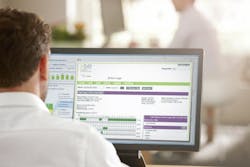TomTom Telematics is rolling out two new items this week: an electronic logging device (ELD) system dubbed WEBFLEET ELD Manager along with the TomTom PRO 2020 “driver terminal” for light vehicles, which provides “detailed connectivity” for large fleets.
WEBFLEET ELD Manager is designed to help motor carriers comply with the ELD mandate going into effect this December by accurately tracking, managing, and sharing records of duty status (RODS) data – synchronizing with a vehicle’s engine to automatically record driving time to more easily obtain and accurately tally hours of service (HOS) information.
TomTom said WEBFLEET ELD Manager incorporates hardware and software components to help fleets comply with the mandate, with key components including: TomTom PRO 8275M/8275M TRUCK, TomTom LINK 530, and a dedicated application for HOS and driver vehicle inspection reports (DVIR) recording, powered by eFleetSuite from Innovation Software Engineering (ISE).
TomTom said eFleetSuite captures all required information for the driver’s log and automatically calculates driver’s time remaining based on various daily and weekly limits. Comprehensive back-office reporting allows fleet personnel to make proactive decisions to avoid HOS violations and focus on resource optimization, the company noted.
Integral to the WEBFLEET ELD Manager solution, the TomTom PRO 8275M is a fully customizable and connected open platform driver terminal, with many readymade apps already available in the TomTom Telematics app center.The company noted it combines the latest navigation and fleet technology in a ruggedized 7-in. touchscreen driver terminal with lifetime maps and lifetime TomTom Traffic truck specific routing (where required), rear camera support, and near field communications. Through TomTom LINK 530, the TomTom PRO 8275M also connects to WEBFLEET for online fleet management, said Torsten Gruenzig, director of North American sales for TomTom Telematics in a statement.
“This is a compliance solution that fleets can rely on, delivered by a trusted global brand,” he added. “WEBFLEET ELD Manager and the TomTom PRO 8 series driver terminals offer fleet businesses so much more value than just providing peace of mind around compliance. Our complete, turnkey solution can be customized to a fleet’s business processes and workflows … so they can run their operations with greater efficiency, and leverage data to make better business decisions.”
WEBFLEET ELD Manager will be available this summer, with existing TomTom Telematics customers able to purchase it for $15.00 per vehicle per month. A subscription to TomTom WEBFLEET is required. Connectivity is not included.
Customers can contact [email protected] for further information.
On another track, TomTom Telematics is also rolling out the new TomTom PRO 2020 driver terminal, which includes forced driver identification, digital mileage log, working time log and “driver behavior improvement” features.Designed for large light vehicle fleet owners using TomTom’s WEBFLEET system, it combined wat TomTom calls “four essential features” into one unit to bring greater visibility and efficiency to the fleet manager, the driver and the fleet business as a whole:
- Driver ID to know who is driving, with a “buzzer alert” to ensure authentication;
- Mileage Log for capturing business and private mileage;
- Working Times so individual employees can log specific time periods to better comply with legislation and policy; and
- OptiDrive 360, which empowers drivers to improve driving performance with visual and audible feedback as they drive.
By packaging these with an interactive touchscreen interface, TomTom said its PRO 2020 creates an “engaging experience” for the driver, which is more effective at helping to changing their behavior and improving their “driving style.”
TomTom’s Grunzig noted in a statement that its simplicity enables and encourages accurate logging of work times and business/private trip data, and its compact screen size (2.5-in.) means it can be fitted to the vehicle dashboard without taking up too much space.
“Owners of large fleets often find connecting all their vehicles can be challenging and expensive,” he explained. “By giving fleet owners a consistent way of collecting data across their whole fleet, we are not only helping to reduce the total cost of ownership across the fleet, but we are also helping them to more easily, more quickly and more efficiently reach their goals.”





